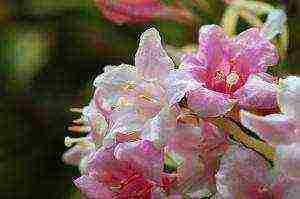Content
- 1 Viburnum varieties for the north
- 2 Viburnum varieties for central regions
- 3 Viburnum varieties for the southern regions
- 4 The history of growing viburnum
- 5 Types of viburnum
- 6 The best varieties of viburnum
- 7 Features of planting and transplanting a viburnum bush
- 8 Fertilization and watering
- 9 Correct pruning of viburnum
- 10 Reproduction of viburnum
- 11 Disease and pest control
- 12 Video: proper planting and caring for viburnum
- 13 Vigorovskaya
- 14 Maria
- 15 Ulgen
- 16 Red Bunch
- 17 Zholobovskaya
As you know, viburnum is a medium-sized shrub or small tree that bears fruits that ripen in late August or September. They are scarlet in color with juicy pulp and a very large seed inside. These berries are used in cooking, for medicinal purposes, they are eaten both processed and fresh.
Viburnum berries
In Russia, viburnum has been known for a long time, it is ranked among the primordially Russian cultures along with mountain ash and birch. Real breeding work was started in our country with viburnum only at the end of the twentieth century, that is, relatively recently.
The very first varieties of viburnum appeared in the State Register of Breeding Achievements in 1995, only 22 years ago, they are relevant to this day, these are cultivars: Zholobovskaya, Souzga and Ulgen. The newest variety was included in the State Register in 2016; this is the cultivar Aurora. In total, at the moment, 14 varieties of this wonderful culture are included in the State Register.
It is interesting that the viburnum does not have a strict gradation by region, it is a universal culture with a set of properties that allow one or another variety to be successfully grown in regions that are completely different in terms of climatic characteristics. It is conditionally possible to divide the viburnum varieties available in the State Register into three large groups - those varieties that are more suitable for the northern regions, because they are highly winter-hardy; varieties that give the best yields in the center, with its longer than in the north, a warm period and plenty of moisture; and varieties that will give record yields only in the south, where droughts are not so uncommon. As a result, six varieties can be distinguished and recommended for the northern regions and four varieties each - for the center of Russia and the south of the country.
See also our detailed articles: Fruit varieties of viburnum and viburnum - all about growing.
Viburnum varieties for the north
Let's start with the northern regions, here varieties such as Zarnitsa, Shukshinskaya, Vigorovskaya, Zakat, Maria and Ryabinushka will feel better.
Viburnum variety Zarnitsa, - ripens in early September, the fruits are bitter, so it is better to process them. The plant looks more like a tree than a bush, forms up to five skeletal branches, gives little growth. The fruits are arranged in an umbrella-shaped scutellum, they are not very large, about 0.65 g, the shape is ellipse, the color is light red. Fruits contain up to 8% sugars, more than 110 mg% ascorbic acid and anthocyanins. Tasters rate the taste of this variety at 3.6-3.8 points out of five. The variety is distinguished by the highest winter hardiness and a fairly good yield - about four kilograms of fruits per plant.
Viburnum Shukshinskaya, - this variety ripens in early September. Outwardly, this bush (not a tree) has up to six skeletal branches and grows quite actively. The leaf blades are light green, turn purple closer to autumn. The fruits are arranged in an umbrella-shaped scutellum, they have a spherical shape and a mass of about 0.55 g. The color of the berries is crimson-scarlet, the taste is good, but the bitterness is palpable. Fruits contain up to 10% sugars, more than 55 mg% ascorbic acid, anthocyanins.The variety is highly winter-hardy, partially self-fertile and reproduces well with green cuttings. The yield is about three kilograms per plant.
Viburnum Vigorovskaya, - this variety is obtained from crossing Taiga rubies and Ulgeni. The fruits of the variety ripen closer to mid-September. Plants of the variety are shrubs with three to five skeletal branches and reaching a height of three meters. The fruits are arranged in umbrella-shaped scutes. The leaves are green with pronounced lobes. Fruits have the shape of a ball, their mass is from 0.51 to 0.53 g. The pulp of berries with an abundance of juice, which contains up to 13.9% of sugars, slightly more than 1.5% of various acids of which up to 45 mg% of ascorbic acid. The taste of the berries is very pleasant, the bitterness is practically not felt, the taste is rated by tasters at 4.3 points, which is a very high indicator for viburnum. The plants themselves are highly winter-resistant and productive (about five kilograms per plant).
Kalina grade Zarnitsa
Viburnum variety Sunset, - the fruits of this variety are ready to be harvested in early September, they taste very bitter, and therefore are suitable only for processing. Plants are shrubs with straight shoots, rather vigorous. Ripe berries, for viburnum, are rather large, about 0.72 g, their shape is round, fully ripe, they acquire a rich scarlet color. The yield is very high - more than seven kilograms per bush. The variety is highly winter-hardy, resistant to pests and diseases.
Viburnum Maria, - the berries of this variety can be picked at the very end of August, the fruits are quite pleasant to the taste, there is bitterness, but it is unobtrusive, so the berries can be eaten fresh or put into processed products. Plants of the variety are shrubs with a slightly spreading crown. The leaf blades are very large and green. The fruits are medium in weight, usually from 0.61 to 0.63 g, their shape is round, when fully ripe, they become light scarlet. The yield is quite high - up to ten kilograms per adult plant. This variety is highly winter-resistant, is not affected by diseases, from pests only sometimes it is attacked by aphids.
Ryabinushka, - this variety was obtained by simple selection among viburnum seedlings near the Bogataya River. As a result, a variety was obtained, the fruits of which ripen at the very beginning of September, but do not have a good taste, they are noticeably bitter. The plant of the variety is a very sprawling bush with large leaf blades of a dark green color. The fruits of the variety have an oval shape, a rather dense skin, they are devoid of a "viburnum" aroma, unpleasant for many; the berries are quite large, more than nine kilograms of harvest can be harvested from one adult plant. The variety is highly winter-hardy and just ideal for growing in the northern regions.
Viburnum variety Sunset
Viburnum varieties for central regions
In the center of Russia, such varieties as Zholobovskaya, Souzga, Ulgen and Taiga rubies will show themselves better in terms of yield and marketability of berries.
Viburnum variety Zholobovskaya, - obtained by selection among viburnum seedlings in the wild. The fruits are ready to be harvested in mid-September. Plants of this variety are shrubs with a very compact crown. When planted in two years, the first fruits can be obtained in the third or fourth year. The berries are collected in an umbrella-shaped scutellum, they are slightly elongated and have a spherical shape and a bright red color. The average weight of the berry is about 0.58 g, each has a rather juicy pulp with a barely perceptible bitterness, we can say that the fruits are sweet. The tasting score is about 4.1 points, which is a very good indicator for viburnum. Each viburnum fruit contains up to 18% dry matter, more than 11% sugars, about 1.5% acids, up to 115 mg% ascorbic acid and over 715 mg% P-active compounds. The maximum yield of the variety is about five kilograms per bush. Alas, the variety requires pollinators and needs additional watering.
Viburnum Souzga, - the variety is obtained by selection among wild-growing seedlings of viburnum.The fruits ripen towards the end of September. Plants of this variety are rather compact bushes, giving the first harvest 3-4 years after two-year-olds are planted on the site. The berries are arranged in an umbrella-shaped scutellum, they are spherical and deep red in color when fully ripe. The average fruit weight is about 0.66 g, they all have a juicy pulp, with a barely noticeable bitterness. The taste is rated by tasters at 3.7-3.9 points. Each fruit contains up to 10% sugars, about 1.9% acids, more than 137 mg% ascorbic acid and over 580 mg% P-active compounds. The maximum yield reaches 6.6 kg per bush. Alas, the variety is self-fertile, requires pollinating varieties on the site and needs additional irrigation.
Kalina grade Zholobovskaya
Viburnum variety Ulgen, - this variety was obtained by selection among seedlings that grew in nature. The fruits ripen around mid-September. Plants of this variety are shrubs with a compact crown and begin bearing fruit for 3-4 years, when planted in two years. The berries are arranged in an umbrella-shaped scutellum, they have a spherical-elliptical shape and a deep red color. The average weight of a berry is about 0.69 g, each has a juicy pulp with a slightly bitter aftertaste. The taste is estimated by the tasters at 4.1 points. Each fruit of this variety contains up to 12.5% sugars, about 1.9% acids, more than 129 mg% ascorbic acid and up to 560 mg% P-active compounds. The maximum yield per bush is about four kilograms. Alas, the variety is self-fertile, requires pollinating varieties on the site and needs additional irrigation.
Viburnum Taiga rubies, - this variety was obtained by selection among seedlings from free pollination of Viburnum vulgaris. The fruits ripen closer to the beginning of September. Plants of the variety are typical shrubs, reaching a height of three meters and having a crown of the same diameter as the height of the plant. The fruits are arranged in an umbrella-shaped scutellum, they have a spherical shape and reach a mass of 0.51 g. Each berry contains up to 9.6% sugars, more than 1.5% acids, about 130 mg% ascorbic acid and up to 668 mg% P-active connections. The taste is bitter, but the sweetness is also felt, so the tasters rate the taste at 3.4-3.6 points. The variety reproduces well with green cuttings, gives a yield of about three kilograms per bush and requires additional watering.
Viburnum grade Taiga rubies
Viburnum varieties for the southern regions
For the south, varieties that are moderately demanding on moisture are also suitable, withstanding small dry periods and in such conditions capable of giving high yields, these are: Red Bunch, Elixir, Pomegranate Bracelet and Aurora.
Viburnum Red bunch, - the fruits ripen around the middle of September. Plants of this variety are shrubs with a slightly spreading crown and large, dark green color, leaf blades. The berries in the south grow quite large - up to 0.75 g, their shape is round, the color is dark red. Taste in southern conditions without bitterness. The yield is about five kilograms per bush. The variety does not require pollinating varieties and additional irrigation, and is able to withstand drought.
Viburnum variety Elixir, - the fruits ripen closer to the middle of September. Plants of this variety are shrubs with a slightly spreading crown and large, dark green leaf blades. The fruits are arranged in umbrella-shaped panicles, each berry has a rounded shape and burgundy color. The taste of the fruit can be called sweet, the bitterness in the south is almost invisible. Fruit weight reaches 0.81 g, and the maximum yield is up to five kilograms per bush. Each berry contains up to 10% sugars, less than 2% acids, up to 60 mg% ascorbic acid and above 1000 mg% pectin. The variety tolerates heat and drought well, does not require additional watering and pollinating varieties.
Viburnum variety Red bunch
Viburnum Garnet bracelet, - the fruits of this variety ripen in the first decade of September. Plants of the variety are typical bushes of medium height with a slightly spreading crown.The leaf blades are medium in size, green in color. The berries are rather large, exceed the weight of 0.81 g, have an oval shape, slightly elongated at the apex and a dark red color. The maximum yield is about five kilograms per bush. Each berry contains up to 10.5% sugars, about 2% acids, over 32 mg% ascorbic acid. The taste of the berries is very pleasant, so the tasters rate it at 4.4 points maximum for viburnum. The variety is not afraid of heat and drought.
Aurora, - the fruits of this variety ripen closer to mid-September. Plants of the variety are low-growing shrubs, with a slightly spreading crown. The leaf blades are small, light green in color. The berries are very large, up to 0.71 g, they have a rounded shape, rich red color. The maximum yield is about five kilograms per bush. The fruits contain up to 8% sugars, slightly more than 2% acids, over 42 mg% ascorbic acid. The taste of the fruit in the south is quite pleasant; tasters rate it at 4.1 points. The variety is not afraid of drought.
Viburnum grade Pomegranate bracelet
All these varieties can be safely grown in these regions, they have been tested and proven to be reliable.
At any time of the year, the viburnum bush is an adornment of the garden plot: at the time of flowering, white fragrant flowers envelop the viburnum bush in a fragrant cloud, in the summer day its fruits are poured with juice, in autumn full-weight clusters sparkle against the background of red-crimson foliage. Add to this poetic picture legends and legends that say that this tree is a symbol of love, happiness and beauty, and you will definitely decide that viburnum should definitely grow next to your home.
The history of growing viburnum
In nature, viburnum is widespread throughout most of the northern hemisphere, in the Andes, the Antilles and Madagascar. On the territory of the former USSR, viburnum was found almost everywhere in the European part, in Western and Central Siberia, in the eastern and northern regions of Kazakhstan.
The name of the plant is translated from Latin as "vine", "twig". The flexibility of viburnum shoots made it possible to use it for the manufacture of various wicker products. There are many versions about the origin of the Slavic name of the plant. It is associated with the color of ripe fruits (they are similar to the color of a red-hot metal), with the sweetness of berries after they have been calcined by frost, with the shape of the leaves (they are carved, resemble a wedge, maple leaves).
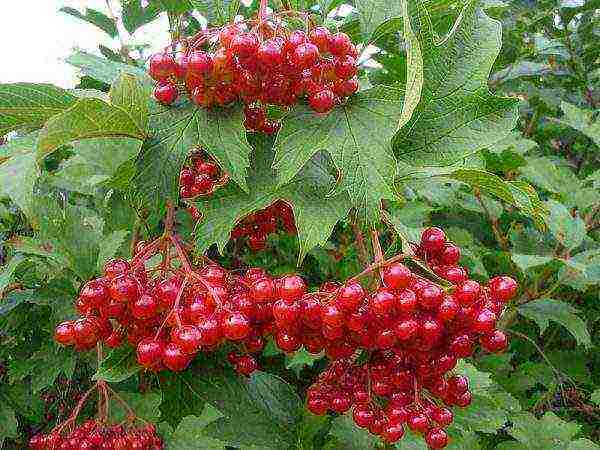
Viburnum fruits ripen in late summer - early autumn
Kalina from ancient times was planted near the farmsteads. Its berries were everywhere eaten as a filling for Kalinnik pies, rubbed with honey, used for medicinal and cosmetic purposes, and the timing of agricultural work was determined by its flowering.
It was believed that this tree is endowed with the ability to drive away evil spirits. That is why viburnum branches were used as decoration during various rituals and festivals. An obligatory attribute of the wedding table was a viburnum bouquet, embodying love, beauty and trust.
Types of viburnum
Viburnum is a shrub or tree with a thin and branched trunk, large leaves and white, sometimes slightly pinkish inflorescences. Viburnum blooms in late spring or early summer. Flowering lasts 1.5 months. The berries, collected in bunches, ripen in autumn. It is better to collect them after the first frost, since a slight frost makes them sweeter and improves their useful properties.
Today there are more than 150 species of this plant. They are very diverse. The most common are deciduous shrubs, but there are evergreen (laurel) and even winter-flowering varieties. They differ in a wide variety of parameters: height, growth rate, fruit color and taste, berry weight.
Photo gallery: variety of viburnum species
The best varieties of viburnum
If you decide to plant viburnum on your site in order to collect a rich harvest of berries or as an ornamental plant, then it is better to purchase varietal. Fruit viburnum, bred by selection, high-yielding, frost-resistant, bears fruit annually. Varietal decorative is distinguished by its singularity and uniqueness during the flowering period.
Table: varieties of viburnum
Photo gallery: varieties of viburnum
Reviews of gardeners about the varieties of viburnum
Features of planting and transplanting a viburnum bush
When choosing a place for planting viburnum, focus on areas with partial shade, with neutral or slightly acidic, well-moistened soil. Viburnum will grow on sandy and podzolic infertile soils, but you will not get a good harvest.
The viburnum grows best on the banks of streams, rivers, artificial reservoirs.
A month before planting, it is recommended to add peat and phosphorus-potassium fertilizers to the soil. Planting a viburnum seedling can be carried out in spring or autumn, guided by the following technology:
- Dig a planting hole about 50x50x50 cm in size.When several plants are planted, a distance of at least 3 m is provided between them.
- The upper fertile soil layer is mixed with peat or humus (1 bucket per planting pit), add 3 tbsp to the mixture. l. urea and 0.5 liters of ash or dolomite flour.
- The seedling is placed vertically in the center of the pit, observing the location of the root collar. It can be deepened by no more than 5 cm.
- The pit with the seedling is covered with prepared soil mixture.
- A hole for watering is organized around the seedling. The initial watering should be abundant (about 30 liters of water).
- The trunk circle is mulched with sawdust, peat.
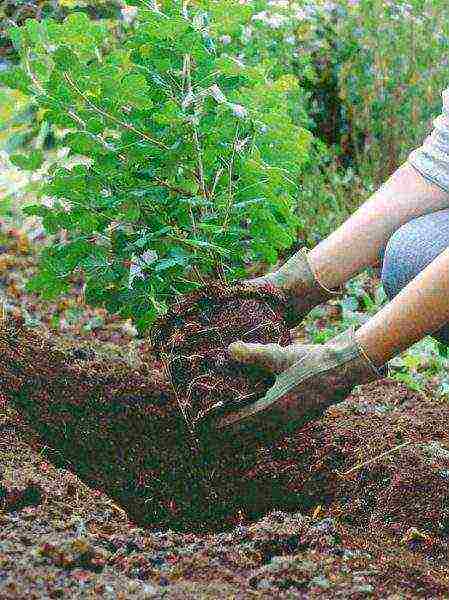
Viburnum seedling needs to be removed from the container and carefully spread the roots
Viburnum transplant
If the viburnum has been planted for a long time, but it grows poorly and bears fruit, you need to think about transplanting the plant. It is necessary in the following cases:
- Kalina does not have enough space for normal growth and development. It is oppressed by outbuildings and other plantings;
- the site is not comfortable for the plant in terms of illumination parameters. The bright midday sun dries up the soil, a strong shade negatively affects the health of the plant;
- as a seedling, you use a fairly mature plant (you took it from friends, neighbors, dug wild viburnum in the forest).
The transplant can be carried out in spring, autumn or summer, following simple rules:
- Preparing a plant for transplanting. It is desirable for the tree to be young and healthy. Damaged branches are removed from it, and then a bush is dug around the trunk. They do this carefully and carefully, trying not to harm the root system. If necessary, remove the thickest root processes, lubricating the cut with charcoal.
- We are preparing a place for a transplant. We dig a planting hole, focusing on the size of the root system, but not less than 50x50x50 cm. To backfill the transplanted plant, we use a soil mixture, which we prepare, as for planting a viburnum seedling.
- After the seedling is sprinkled with earth and the soil around is trampled, at least 2 buckets of water are poured into the hole. This will help compact the soil and remove possible voids.
- If the transplant is carried out in the fall, then, in addition to mulching, it is recommended to insulate, cover the plant for the winter.
- The transplanted plant needs to be pruned. For autumn planting, this procedure can be postponed until spring. Damaged, dry branches are cut at the root, and the rest - 20-25 cm above ground level. This pruning will help rejuvenate the transplanted bush.
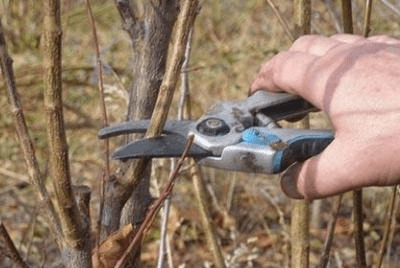
If, after transplanting, the viburnum still does not bloom well, it can be cut almost at the root, leaving the trunk and branches 20 cm from the ground
Fertilization and watering
In dry times, the plant needs watering (twice a week, 2 buckets of water under the bush). To get a good harvest of berries and lush color in decorative forms, it is recommended to feed the viburnum:
- in the spring it is recommended to carry out 2 dressings. Before the buds swell, urea is scattered in the near-stem circle (50 g per 1 m2). Before flowering, you can use potassium sulfide (50 g per 1 m2) or wood ash (1 tbsp. Scatter and lightly dig around the bush);
- in the second half of summer, viburnum needs phosphorus and potassium, so you can apply complex mineral fertilizers (75 g) or 50 g of phosphorus and 25 g of potassium fertilizers per 1 m2;
- every 2 years, when digging up the soil around the viburnum, rotted manure is introduced into the trunk circle (a bucket under the bush).
Important! After sprinkling mineral fertilizers, the bush must be watered. If the weather is dry during summer feeding, it is recommended to dissolve the fertilizers in water.
Correct pruning of viburnum
Viburnum is a fast growing plant. During the year, its branches grow by 50 cm, so the bush must be cut off annually. It is recommended to do this in early spring before the start of sap flow, taking into account the following rules:
- be sure to remove dry, damaged, old (over 6 years old) branches;
- part of the branches in the center of the crown should be removed to ensure good illumination, on which the yield of viburnum depends.
Pruning helps the plant not only develop well and bear fruit, but also allows you to adjust the size and volume of the bush.
With the correct pruning, you can form a small tree from a viburnum bush. In this case, the formation is carried out around the selected central trunk, and all lateral branches and root shoots are removed. When an even trunk with a height of about 2 m is formed, they begin to form the crown. To do this, pinch the central trunk so that it begins to branch.
You also need to know some of the features of pruning different varieties of viburnum. For example, if you grow Buldenezh viburnum, then for the future abundant flowering of the seedling in the first year, it is necessary to cut off the inflorescences that have appeared. This will give the plant an opportunity to direct its forces towards rooting and strengthening. In subsequent years, pruning of the bush is recommended in the fall, so that the plant has time to lay new flower buds for lush flowering next year.
Reproduction of viburnum
There are several ways to reproduce viburnum: by seeds, dividing the bush, using cuttings, vertical and horizontal layering.
Seed propagation
The seed method is used quite rarely for the following reasons:
- this is a rather lengthy process that can take more than 2 years;
- the method does not guarantee the preservation of the varietal characteristics of the plant.
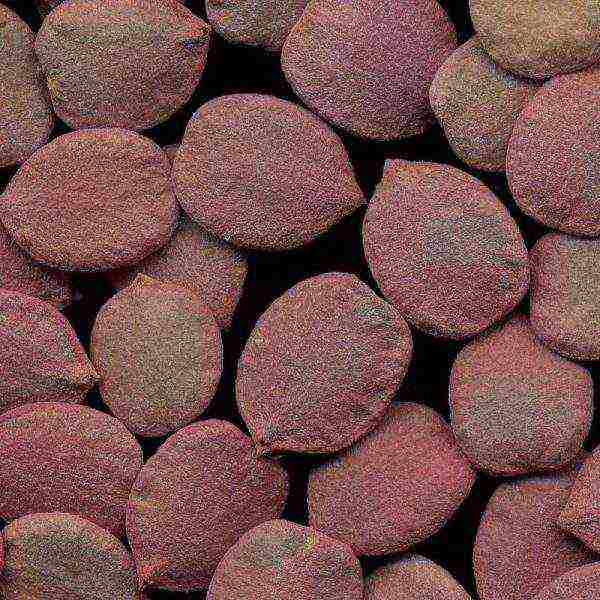
Viburnum seed is flat and heart-shaped
The advantage of such reproduction is the viability and maximum adaptation of the obtained seedlings to the proposed growing conditions. If you sow the seeds in the fall, then the seedlings will appear only after a year. Then small seedlings should overwinter, and only after that they will enter the phase of active growth. This process can be accelerated by stratification:
- The seeds are placed in a humid environment. It can be sand, moss, or sawdust. Containers should be stored at room temperature. After about 2 months, the seeds will begin to hatch.
- Sprouted seeds are placed on the bottom shelf of the refrigerator and kept there for about a month. 3 months of artificial stratification replaces the year during which the seeds would germinate in natural conditions.
- Then the seeds are sown in a container filled with nutrient soil.
- If in the spring the seedlings have grown stronger, gained strength, 2-3 pairs of true leaves have developed on them, then it is recommended to plant them in a nursery located in the open ground. At the same time, they should be provided with regular watering, feeding and shelter for the winter.

In open ground, you can plant a strong seedling that has several pairs of real leaves
- Weak seedlings are left in the planting container, placing it in the open air. It is recommended to plant the remaining seedlings in an open nursery after a year.
- After growing in a nursery, the strongest plants are planted in permanent places.
Viburnum seeds are characterized by poor germination: up to 20% of sowing.
Reproduction by dividing the bush
This method is most acceptable in the presence of a large bush of a good variety of viburnum, which requires transplantation to a new location. The dug out bush is divided into parts with a sharp tool. Root cuts are treated with charcoal.When dividing, make sure that there are at least 3 healthy kidneys in each part. Each part is planted in a separate planting hole, as when transplanting a plant. Viburnum can be propagated by dividing the bush in autumn and spring.
Propagation by cuttings
Cuttings are harvested in the middle of summer. At this time, the branches of the viburnum are particularly flexible, do not break. When cutting, make sure that each stalk is about 10 cm long and has at least 3 knots. The lower cut of the cutting is made oblique, the green leaves are removed. It is advisable to keep the planting material in any root formation stimulator.
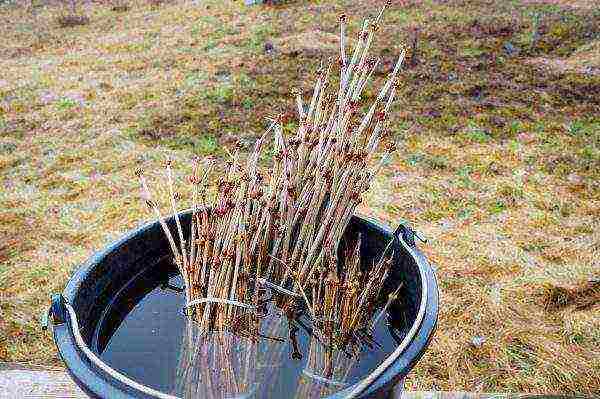
When using any rooting stimulant, you must strictly follow the instructions, since overdose is very dangerous
Then the harvested cuttings are buried 2 cm into the soil mixture, consisting of equal parts of river sand and peat. For good rooting, cuttings need a fairly high temperature (about 30 ° C), so it is better to plant them in a greenhouse. Cuttings need to be watered regularly, and for the winter, be sure to cover them with peat, sawdust or foliage. In the spring, grown healthy seedlings can be planted in a permanent place.
Reproduction by layering
Viburnum can be propagated by both horizontal and vertical layering. For horizontal layering, a mother branch close to the ground is selected, its top is cut off, bent to the ground, pinned with a wire or wooden hook and covered with soil. The top of the shoot is left not sprinkled.
Over the summer, the cuttings will give roots, and young branches will appear from the buds. The cuttings are separated from the parent branch, dug out together with a lump of earth and planted in a permanent place.
It is easy to propagate viburnum with vertical layering. Such reproduction includes the following stages:
- In autumn, the lower branches of a young viburnum bush are cut off, leaving at least 4 buds on them.
- Hilling bushes is carried out.
- In the spring, the shoots that have emerged from the buds are again covered with earth.
- After the shoots grow back up to 25 cm, they can be separated from the mother plant and planted in a new place.
Video: reproduction of viburnum by layering
Disease and pest control
Fungal and bacterial diseases rarely affect viburnum, but they can lead to such troubles as loss of decorativeness, drying out of inflorescences and decay of fruits. It is important to identify and take measures to treat the plant in time.
Table: viburnum diseases
Photo gallery: signs of viburnum diseases
Harmful insects quite often attack viburnum and pose a serious danger to it. The plant loses its decorative effect, flowers and crops may die completely. Timely treatment of the bushes with appropriate compounds will protect the plant from insects.
Table: pests of viburnum
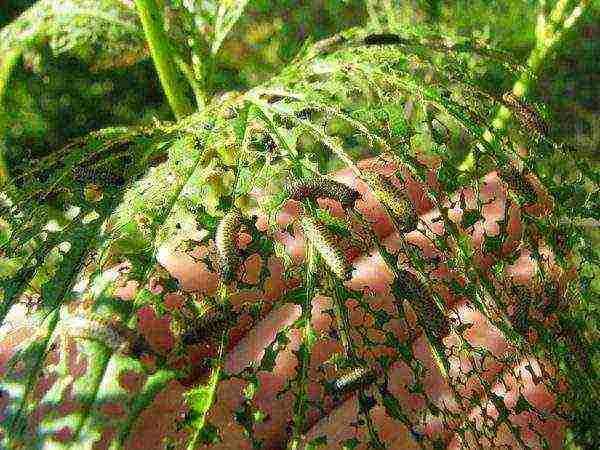
During the years of mass reproduction, the viburnum leaf beetle can gnaw the entire bush so that there will be no greenery left at all
Video: proper planting and caring for viburnum
The viburnum bush is an ideal inhabitant of any garden plot. He will constantly delight you and your guests with decorativeness, unpretentiousness, usefulness and originality.
Rate the article:
(1 vote, average: 5 out of 5)
KALINA
Vigorovskaya
Ripening in early September. Resistant to diseases and pests, frost-resistant. Shrub with 3-5 skeletal axes, up to 3 m high.
Berries up to 9.5 mm in diameter, weighing 0.5 g, spherical, juicy. They contain: sugar 14%, acid 1.6%, vitamin C - 46 mg%. Tasting score 4.2 points. Differs in high dietary and medicinal properties of berries.
Productivity 52 kg / ha.
GNU Research Institute of Horticulture of Siberia named after M.A. Lisavenko.
Garnet bracelet
Medium-late ripening. The variety is resistant to low temperatures, diseases and pests. The bush is medium-sized, medium-spreading.
The berries are large, weight 0.8 g oval, slightly elongated at the top, dark red. They contain: sugar 10.4%, acid 1.9%, vitamin C 31.2 mg%. The taste is sweet and sour with a pleasant bitterness. Tasting score 4.3 points.
Productivity is 120 kg / ha. Suitable for all types of processing and fresh consumption.
GNU All-Russian Research Institute of Horticulture. I.V. Michurin.
Zholobovskaya
Ripens on September 14-15. Winter hardiness is high. The variety is resistant to disease. The bush is compact, begins to bear fruit in the 5th year.
Berries weighing 0.57 g. The pulp is juicy, slightly bitter, almost sweet. Tasting score 4 points. They contain (%): dry matter - 18.5, sugars - 11.8, acids - 1.7; vitamin C - 116.0 mg%, vitamin P 720 mg%.
Self-infertile. Average yield - 25.0 kg / ha, maximum - 53.3 kg / ha (5 to 10 kg per tree). General purpose, small seeds. Needs irrigation or soils provided with natural moisture.
GNU Research Institute of Horticulture of Siberia named after M.A. Lisavenko.
Zarnitsa
Medium ripening. Highly winter-resistant. A tree with 5 skeletal branches.
Berries weighing 0.6 g, ellipsoidally pointed, light red, bitter. They contain: sugar 7.7%, vitamin C 111 mg%. Tasting assessment of berries 3.7 points.
Productivity 46.6 kg / ha (6-11 kg per bush).
For industrial processing of the State Scientific Research Institute of Horticulture of Siberia named after V.I. M.A. Lisavenko.
Red bunch
Medium ripening. Winter hardiness is high. Resistant to pest diseases. The bush is medium-sized, medium-spreading. Shoots are straight, light green.
Berries weighing 0.74 g, round, dark red. The taste is sweet and sour, with reduced bitterness.
The variety is self-fertile, the yield is high, 10–12 kg per bush. Propagated by green cuttings and layering.
GNU All-Russian Research Institute of Genetics and Selection of Fruit Plants. I.V. Michurin.
Souzga
Ripens on September 20-30, high winter hardiness. Disease resistant. The bush is compact, begins to bear fruit in the 5th year.
Berries weighing 0.65 g, spherical, crimson-red. The pulp is juicy, slightly bitter. Tasting score 3.8 points. The berries contain (%): sugars - 10.1, acids - 2.0; vitamin C - 138.0 mg%, vitamin P - 585.0 mg%.
Self-infertile. The yield is high, 50 c / ha, maximum - 83.3 c / ha. (about 5–12 kg per tree). Needs irrigation or soils provided with natural moisture.
GNU Research Institute of Horticulture of Siberia named after M.A. Lisavenko.
Taiga rubies
Ripens in the second decade of September. High winter hardiness, disease resistant. The bush is up to 3 m high with a crown diameter of 2–2.5 m.
The berries are globular, dark red, 9.5 mm in diameter, weighing 0.5 g. The taste is slightly bitter with a sweet taste. Tasting score 3.5 points. They contain: sugar 9.6%, acid 1.6%, vitamins: C - 133 mg%, P - 670 mg%.
Productivity 22.4 kg / ha. The variety is self-fertile, propagated by green cuttings.
GNU Research Institute of Horticulture of Siberia named after M.A. Lisavenko.
Ulgen
Ripens on September 14-15. Winter hardiness is high. The variety is resistant to disease. The bush is compact.
Berries weighing 0.68 g, spherical elliptical, intense red. The pulp is juicy, slightly bitter. Tasting score 4 points. The berries contain (%): sugars - 12.9, acids - 2.0; vitamin C - 130 mg%, vitamin P - 563.5 mg%.
Begins fruiting in the 5th year. Self-infertile. Average yield - 27.0, maximum - 49.3 kg / ha. Universal purpose. Needs irrigation or soils provided with natural moisture.
GNU Research Institute of Horticulture of Siberia named after M.A. Lisavenko.
Shukshinskaya
Medium ripening. Winter hardy. Disease resistant. The bush is vigorous, with 6 skeletal trunks.
The berries are spherical, weighing 0.53 g, crimson-red, slightly bitter. They contain: sugar 10.1%, vitamin C 56 mg%.
The variety is self-fertile, propagated by green cuttings. Average yield 35 kg / ha (4–8 kg per bush).
State Research Institute of Horticulture of Siberia named after M.A. Lisavenko.
Elixir
Medium ripening. Winter hardiness is high. Resistant to diseases, slightly damaged by brown aphids. The bush is medium-sized, slightly spreading.
Berries weighing 0.8 g, round, without edges, burgundy, with a thin skin, sweet and sour, with moderate bitterness, with aroma, refreshing. They contain: sugar 9.6%, acid 1.9%, vitamin C 58.1 mg%, pectin 1010 mg%. Tasting score 3.9 points.
The variety is self-fertile.Productivity - 152 kg / ha.
GNU All-Russian Research Institute of Genetics and Selection of Fruit Plants. I.V. Michurin.
Next chapter>
In Russian culture, as you know, two berries are mentioned more often than others. Raspberries represent a sweet, happy life. And viburnum is a bitter fate. This comparison is based on the taste of the fruit. But scientists decided to break stereotypes, and bred several varieties of viburnum that have no bitterness. Berries can be eaten straight from the tree, without waiting for the frost to pick them up.
More precisely, there is almost no bitterness, because no one has yet been able to get 100% sweet viburnum. But compared to wild ancestors, the fruits of some varieties have a barely noticeable bitterness. True, tasters are cautious - although they give a high score of 4 points for viburnum, they call the taste slightly bitter. Meanwhile, some berries contain quite a lot of sugar.
Vigorovskaya
This is the sweetest variety of viburnum - 14% sugar in berries. And his score is more than high - 4.2 points. Because everything is in moderation here: a little sourness, a little bitterness, as a result, a completely balanced, pleasant taste is obtained.
Fruits and Vigorovskaya are bright red, weighing 0.5-1.5 g. Productivity 6-10 kg per bush.
The plant itself is of medium height - up to 3 meters. Looks very elegant in autumn, when the leaves become brightly colored.
Maria
Unfortunately, reference books do not indicate the amount of sugar in the fruits of this variety. But tasters rate the taste as “sweetish-sour, with light astringency, almost no bitterness” and boldly give 4.2 points, adding that the berries are also very aromatic.
Mary's fruits are light red, weighing about 0.6 g. An average of 8 kg can be harvested from one plant.
The bush grows up to 5 m. It does not get sick and is almost not affected by pests. Looks very impressive in the fall, when the leaves turn crimson-golden.
Ulgen
By the amount of sugar it takes the second place - it is 13% in fruits. Experts rate the taste at 4 points, marked "sweetish, slightly bitter."
Ulgen's fruits are medium-sized, about 0.7 g, but they are collected in very large spectacular brushes - 35-50 pieces each! And they also have a lot of vitamin C - 130 mg (in wild viburnum about 50 mg). Productivity 9-11 kg per bush.
The plant is quite tall - up to 4 m, and sometimes even taller. Loves watering. The variety is resistant to diseases and aphids.
Red Bunch
Here, too, the question arises with the amount of sugar in the fruit, but we will believe the tasters. And they write that the taste of this variety is "sweet and sour, with a little pleasant bitterness" and give a solid four.
The fruits of the Red cluster are bright red, weighing 0.75 g. Low yield - 2.5-4 kg per bush. But the berries are very healing - they contain as much vitamin C as 140 mg! This is the highest among sweet viburnum.
The bush grows compact, no higher than 3 m. Does not get sick, is not affected by pests. In autumn, it glows in the garden with a crimson-scarlet dress of leaves.
Zholobovskaya
